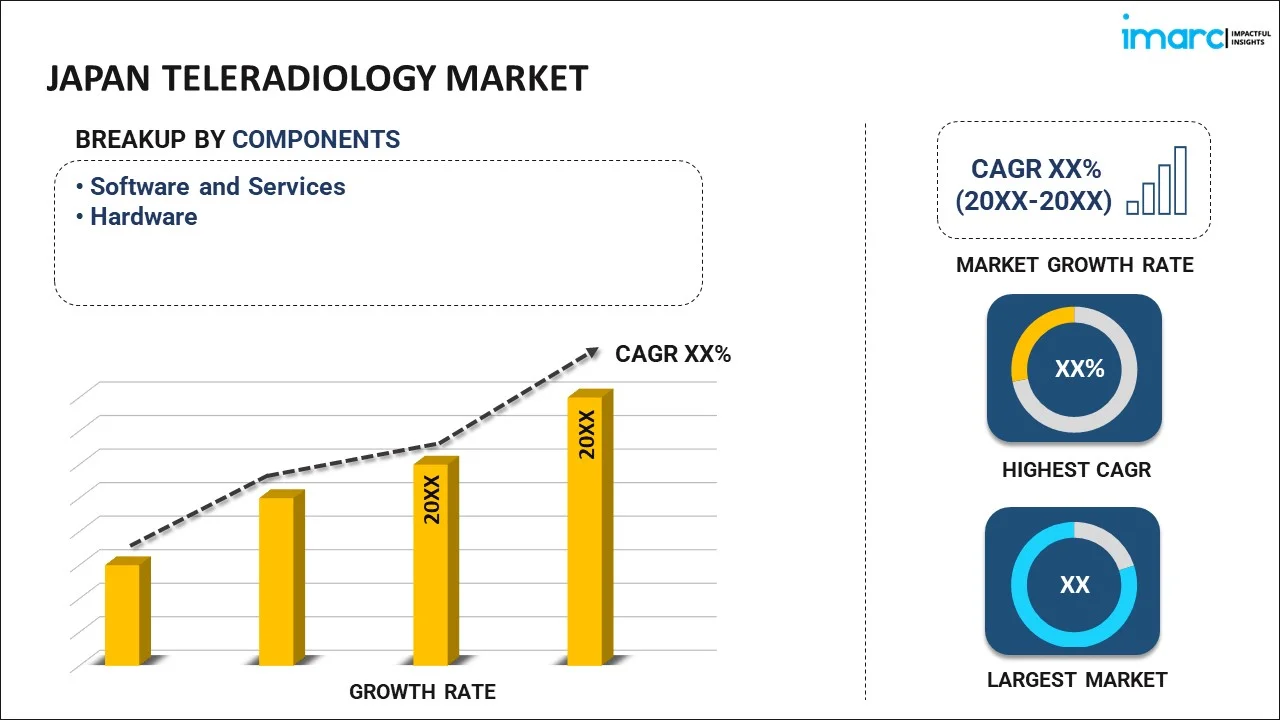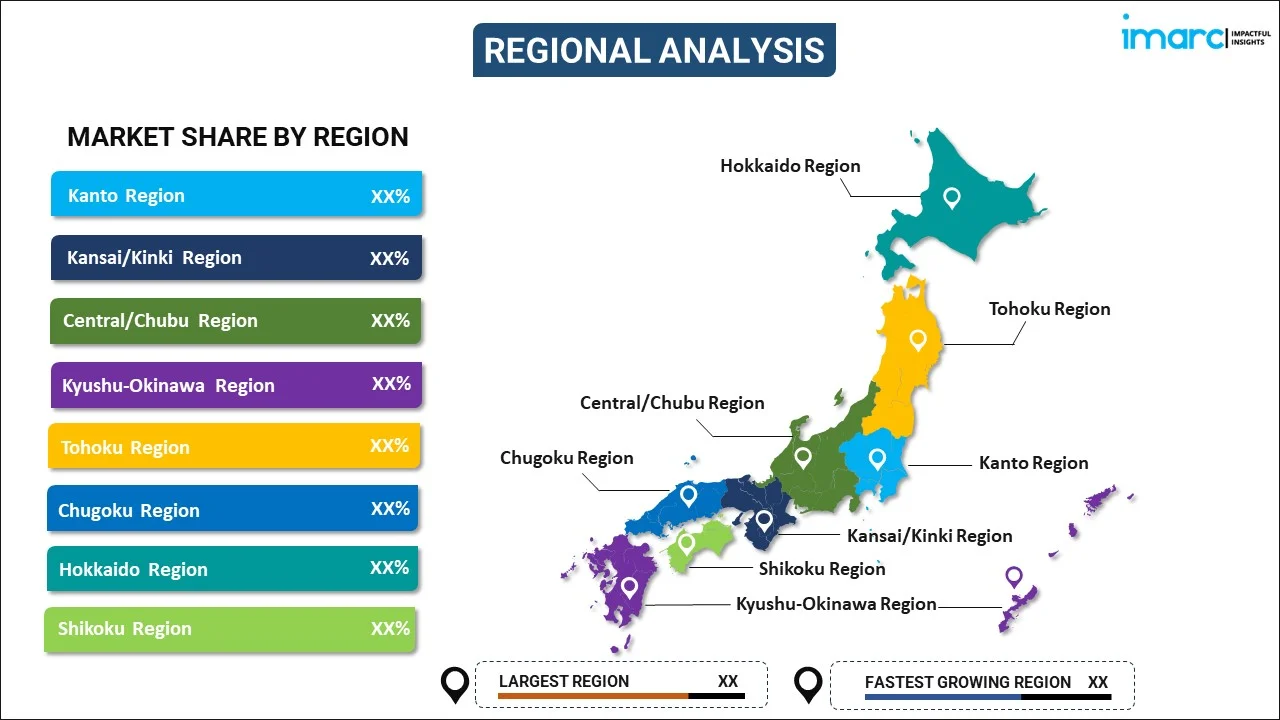
Japan Teleradiology Market Report by Component (Software and Services, Hardware), Imaging Technique (X-rays, Computed Tomography (CT), Ultrasound, Magnetic Resonance Imaging (MRI), Nuclear Imaging, and Others), End User(Hospitals and Clinics, Ambulatory Surgical Centers, Diagnostic Centers, and Others), and Region 2025-2033
Market Overview:
Japan teleradiology market size reached USD 395 Million in 2024. Looking forward, IMARC Group expects the market to reach USD 1,336 Million by 2033, exhibiting a growth rate (CAGR) of 14.5% during 2025-2033. The rising digitization of healthcare records and processes, which has made it easier to transmit and store medical images digitally, making teleradiology more accessible and efficient, is primarily driving the market.
|
Report Attribute
|
Key Statistics
|
|---|---|
|
Base Year
|
2024 |
|
Forecast Years
|
2025-2033 |
|
Historical Years
|
2019-2024
|
| Market Size in 2024 | USD 395 Million |
| Market Forecast in 2033 | USD 1,336 Million |
| Market Growth Rate (2025-2033) | 14.5% |
Teleradiology is a medical field that involves the remote interpretation of medical images, such as X-rays, MRIs, CT scans, and ultrasounds, by radiologists located in different locations from where the images are taken. This technology-driven practice allows for rapid access to expert radiology services, especially in underserved or remote areas, improving patient care and reducing diagnostic delays. Healthcare facilities and radiology centers send digital images securely over the Internet to remote radiologists, who then analyze and provide diagnostic reports electronically. Teleradiology enhances collaboration among healthcare providers, enabling timely diagnoses, treatment planning, and consultation with specialists when needed. It is particularly valuable in emergency situations and during off-hours when on-site radiologists may not be available. The growth of teleradiology has been facilitated by advances in technology and digital imaging, making it an essential tool for enhancing healthcare accessibility, reducing costs, and improving patient outcomes by harnessing the expertise of radiologists regardless of their physical location.
Japan Teleradiology Market Trends:
The teleradiology market in Japan is experiencing robust growth due to several compelling market drivers. Firstly, advancements in telecommunications technology have significantly improved the speed and quality of image transmission, enabling radiologists to remotely access and interpret medical images with unprecedented efficiency. Consequently, healthcare institutions can tap into a pool of radiology experts, reducing turnaround times and ensuring timely diagnoses, which is particularly crucial in emergency cases. Moreover, the ever-increasing demand for diagnostic imaging services, driven by an aging population and the rising prevalence of chronic diseases, has created a substantial need for teleradiology services. This escalating demand, coupled with a shortage of on-site radiologists in many regions, has paved the way for the expansion of teleradiology solutions. Furthermore, the growing importance of remote healthcare solutions, since many healthcare providers seek to minimize in-person contact while maintaining diagnostic capabilities, is expected to drive the teleradiology market in Japan during the forecast period.
Japan Teleradiology Market Segmentation:
IMARC Group provides an analysis of the key trends in each segment of the market, along with forecasts at the country level for 2025-2033. Our report has categorized the market based on component, imaging technique, and end user.
Component Insights:

- Software and Services
- Hardware
The report has provided a detailed breakup and analysis of the market based on the component. This includes software and services and hardware.
Imaging Technique Insights:
- X-rays
- Computed Tomography (CT)
- Ultrasound
- Magnetic Resonance Imaging (MRI)
- Nuclear Imaging
- Others
A detailed breakup and analysis of the market based on the imaging technique have also been provided in the report. This includes X-rays, computed tomography (CT), ultrasound, magnetic resonance imaging (MRI), nuclear imaging, and others.
End User Insights:
- Hospitals and Clinics
- Ambulatory Surgical Centers
- Diagnostic Centers
- Others
The report has provided a detailed breakup and analysis of the market based on the end user. This includes hospitals and clinics, ambulatory surgical centers, diagnostic centers, and others.
Regional Insights:

- Kanto Region
- Kansai/Kinki Region
- Central/ Chubu Region
- Kyushu-Okinawa Region
- Tohoku Region
- Chugoku Region
- Hokkaido Region
- Shikoku Region
The report has also provided a comprehensive analysis of all the major regional markets, which include Kanto Region, Kansai/Kinki Region, Central/ Chubu Region, Kyushu-Okinawa Region, Tohoku Region, Chugoku Region, Hokkaido Region, and Shikoku Region.
Competitive Landscape:
The market research report has also provided a comprehensive analysis of the competitive landscape. Competitive analysis such as market structure, key player positioning, top winning strategies, competitive dashboard, and company evaluation quadrant has been covered in the report. Also, detailed profiles of all major companies have been provided.
Japan Teleradiology Market Report Coverage:
| Report Features | Details |
|---|---|
| Base Year of the Analysis | 2024 |
| Historical Period | 2019-2024 |
| Forecast Period | 2025-2033 |
| Units | Million USD |
| Scope of the Report | Exploration of Historical Trends and Market Outlook, Industry Catalysts and Challenges, Segment-Wise Historical and Future Market Assessment:
|
| Components Covered | Software and Services, Hardware |
| Imaging Techniques Covered | X-rays, Computed Tomography (CT), Ultrasound, Magnetic Resonance Imaging (MRI), Nuclear Imaging, Others |
| End Users Covered | Hospitals and Clinics, Ambulatory Surgical Centers, Diagnostic Centers, Others |
| Regions Covered | Kanto Region, Kansai/Kinki Region, Central/ Chubu Region, Kyushu-Okinawa Region, Tohoku Region, Chugoku Region, Hokkaido Region, Shikoku Region |
| Customization Scope | 10% Free Customization |
| Post-Sale Analyst Support | 10-12 Weeks |
| Delivery Format | PDF and Excel through Email (We can also provide the editable version of the report in PPT/Word format on special request) |
Key Questions Answered in This Report:
- How has the Japan teleradiology market performed so far and how will it perform in the coming years?
- What has been the impact of COVID-19 on the Japan teleradiology market?
- What is the breakup of the Japan teleradiology market on the basis of component?
- What is the breakup of the Japan teleradiology market on the basis of imaging technique?
- What is the breakup of the Japan teleradiology market on the basis of end user?
- What are the various stages in the value chain of the Japan teleradiology market?
- What are the key driving factors and challenges in the Japan teleradiology?
- What is the structure of the Japan teleradiology market and who are the key players?
- What is the degree of competition in the Japan teleradiology market?
Key Benefits for Stakeholders:
- IMARC’s industry report offers a comprehensive quantitative analysis of various market segments, historical and current market trends, market forecasts, and dynamics of the Japan teleradiology market from 2019-2033.
- The research report provides the latest information on the market drivers, challenges, and opportunities in the Japan teleradiology market.
- Porter's five forces analysis assist stakeholders in assessing the impact of new entrants, competitive rivalry, supplier power, buyer power, and the threat of substitution. It helps stakeholders to analyze the level of competition within the Japan teleradiology industry and its attractiveness.
- Competitive landscape allows stakeholders to understand their competitive environment and provides an insight into the current positions of key players in the market.
Need more help?
- Speak to our experienced analysts for insights on the current market scenarios.
- Include additional segments and countries to customize the report as per your requirement.
- Gain an unparalleled competitive advantage in your domain by understanding how to utilize the report and positively impacting your operations and revenue.
- For further assistance, please connect with our analysts.
 Inquire Before Buying
Inquire Before Buying
 Speak to an Analyst
Speak to an Analyst
 Request Brochure
Request Brochure
 Request Customization
Request Customization




.webp)




.webp)












